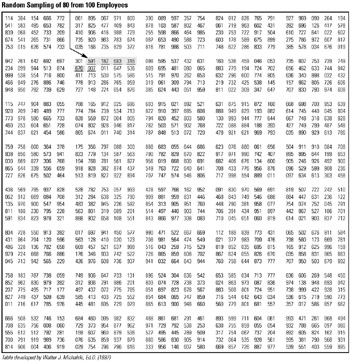Tool 158: Random Numbers Generator
| AKA | Random Numbers Table, Sampling Chart |
| Classification | Data Collecting (DC) |
Tool description
The random numbers generator is a research and tool that conveniently allows a simple random sampling process to be completed in a completely unbiased fashion within a relatively short time. A simple random sampling method allows each member of a population an equal probability to be included in a sample drawn from the same population.
Typical application
-
To generate a valid sample from an identified population using simple random sampling method.
-
To provide a convenient method of selecting an unbiased sample of predetermined size from a target population.
Problem-solving phase
| Select and define problem or opportunity | |
| → | Identify and analyze causes or potential change |
| Develop and plan possible solutions or change | |
| Implement and evaluate solution or change | |
| → | Measure and report solution or change results |
| Recognize and reward team efforts |
Typically used by
| 1 | Research/statistics |
| Creativity/innovation | |
| Engineering | |
| Project management | |
| Manufacturing | |
| 4 | Marketing/sales |
| Administration/documentation | |
| Servicing/support | |
| 2 | Customer/quality metrics |
| 3 | Change management |
before
-
Data Collection Strategy
-
Sampling Methods
-
Demographic Analysis
-
Audience Analysis
-
Consensus Decision Making
after
-
Normal Probability Distribution
-
Surveying
-
Interview Technique
-
Observation
-
Analysis of Variance
Notes and key points
-
During the extracting of the numbers for the random sample from the random numbers generator, skip the numbers that:1) are repeated, and 2) are higher than the highest number in the population range. Example: If population size is 100, skip number 101 if it should come up in the table.
Step-by-step procedure
-
STEP 1 Determine or estimate the size of the target population that will be used as the source for a random sample.
-
STEP 2 On the basis of the population size, look up the required size of the sample by referring to a sample size determination table found in most statistics textbooks.
-
STEP 3 The next step considers the size of the sample to be taken. The identified number of employees = 100. At first, a list of employee names or identification numbers is prepared to reflect 00–99. Referring to a sample size determination table (at the 95 percent confidence level), the sample size for N = 100 was found to be 80. See example A Random Sampling of 80 from 100 Employees.
-
STEP 4 Using a random numbers generator table (RNGT), select a random sample. First, an unbiased starting point needs to be identified. The selecting of a starting point can be accomplished in three ways: 1) Ask a person to point to any number on the RNGT; 2) face away from the tale and using a pencil behind your back, mark a number of the RNGT for a starting point, or 3) use a watch or calendar to retrieve the numbers (any digits are fine) to be used as a starting point on the RNGT. Suppose that the unbiased starting point selected was 591, this would give you 59 as the first number since the population range is only 00-99 (counting down vertically the first, then the second column to the tenth 5 5 matrix, two spaces to the right is 591). The next five numbers are 18, 68, 31, 67, and 00. This process of selecting numbers continues until all 80 numbers have been drawn for the sample.
Note Skip any repeated number that comes up and any number that is greater than 79! (Remember, 00-79 = 80 numbers.)
-
STEP 5 Cross-reference the selected numbers to the employees. This is your random sample.
Example of tool application

EAN: 2147483647
Pages: 326